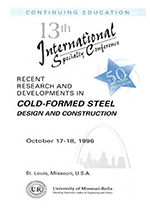Session Dates
17 Oct 1996
Abstract
The most recent editions of the North American Design Standards present a unified effective width approach for the design of compressive elements. This paper outlines a comparison of various modifications to the existing procedure used to calculate the effective width of a simple edge-stiffener subjected to a stress gradient. The comparison involves three methods where the magnitude of the compressive stress is altered, and two stress gradient methods where the plate bucking coefficient is based on the ratio of compressive stresses at the top and bottom of the flat width of the simple edge-stiffener. Analysis of these methods was carried out using specimens tested at the University of Waterloo and data available in the literature. Results of the comparison indicate that the variation in statistical values between the five effective width methods is marginal. Therefore, it is recommended that the current procedures used to calculate the effective width of simple edge-stiffeners subjected to a stress gradient remain unchanged in the North American Design Standards.
Department(s)
Civil, Architectural and Environmental Engineering
Research Center/Lab(s)
Wei-Wen Yu Center for Cold-Formed Steel Structures
Meeting Name
13th International Specialty Conference on Cold-Formed Steel Structures
Publisher
University of Missouri--Rolla
Document Version
Final Version
Rights
© 1996 University of Missouri--Rolla, All rights reserved.
Document Type
Article - Conference proceedings
File Type
text
Language
English
Recommended Citation
Rogers, Colin A. and Schuster, R. M., "Effective Width of a Simple Edge-stiffener Subjected to a Stress Gradient" (1996). CCFSS Proceedings of International Specialty Conference on Cold-Formed Steel Structures (1971 - 2018). 3.
https://scholarsmine.mst.edu/isccss/13iccfss/13iccfss-session1/3
Effective Width of a Simple Edge-stiffener Subjected to a Stress Gradient
The most recent editions of the North American Design Standards present a unified effective width approach for the design of compressive elements. This paper outlines a comparison of various modifications to the existing procedure used to calculate the effective width of a simple edge-stiffener subjected to a stress gradient. The comparison involves three methods where the magnitude of the compressive stress is altered, and two stress gradient methods where the plate bucking coefficient is based on the ratio of compressive stresses at the top and bottom of the flat width of the simple edge-stiffener. Analysis of these methods was carried out using specimens tested at the University of Waterloo and data available in the literature. Results of the comparison indicate that the variation in statistical values between the five effective width methods is marginal. Therefore, it is recommended that the current procedures used to calculate the effective width of simple edge-stiffeners subjected to a stress gradient remain unchanged in the North American Design Standards.



